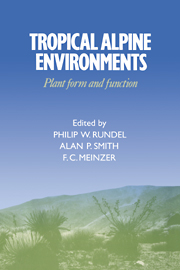Book contents
- Frontmatter
- Contents
- List of contributors
- Preface
- 1 Introduction to tropical alpine vegetation
- 2 Tropical alpine climates
- 3 Páramo microclimate and leaf thermal balance of Andean giant rosette plants
- 4 Comparative water relations of tropical alpine plants
- 5 Cold tolerance in tropical alpine plants
- 6 Anatomy of tropical alpine plants
- 7 Environmental biology of a tropical treeline species, Polylepis sericea
- 8 Morphological and physiological radiation in páramo Draba
- 9 Sediment-based carbon nutrition in tropical alpine Isoetes
- 10 Functional significance of inflorescence pubescence in tropical alpine species of Puya
- 11 Turnover and conservation of nutrients in the pachycaul Senecio keniodendron
- 12 Soil nutrient dynamics in East African alpine ecosystems
- 13 An overview of the reproductive biology of Espeletia (Asteraceae) in the Venezuelan Andes
- 14 Population biology of Mount Kenya lobelias
- 15 Population biology of Senecio keniodendron (Asteraceae), an Afroalpine giant rosette plant
- 16 Population dynamics and flowering in a Hawaiian alpine rosette plant, Argyroxiphium sandwicense
- 17 Plant form and function in alpine New Guinea
- 18 Alpine herbivory on Mount Kenya
- 19 Biotic interactions in Hawaiian high elevation ecosystems
- 20 Tropical alpine ecology: progress and priorities
- Index
8 - Morphological and physiological radiation in páramo Draba
Published online by Cambridge University Press: 21 October 2009
- Frontmatter
- Contents
- List of contributors
- Preface
- 1 Introduction to tropical alpine vegetation
- 2 Tropical alpine climates
- 3 Páramo microclimate and leaf thermal balance of Andean giant rosette plants
- 4 Comparative water relations of tropical alpine plants
- 5 Cold tolerance in tropical alpine plants
- 6 Anatomy of tropical alpine plants
- 7 Environmental biology of a tropical treeline species, Polylepis sericea
- 8 Morphological and physiological radiation in páramo Draba
- 9 Sediment-based carbon nutrition in tropical alpine Isoetes
- 10 Functional significance of inflorescence pubescence in tropical alpine species of Puya
- 11 Turnover and conservation of nutrients in the pachycaul Senecio keniodendron
- 12 Soil nutrient dynamics in East African alpine ecosystems
- 13 An overview of the reproductive biology of Espeletia (Asteraceae) in the Venezuelan Andes
- 14 Population biology of Mount Kenya lobelias
- 15 Population biology of Senecio keniodendron (Asteraceae), an Afroalpine giant rosette plant
- 16 Population dynamics and flowering in a Hawaiian alpine rosette plant, Argyroxiphium sandwicense
- 17 Plant form and function in alpine New Guinea
- 18 Alpine herbivory on Mount Kenya
- 19 Biotic interactions in Hawaiian high elevation ecosystems
- 20 Tropical alpine ecology: progress and priorities
- Index
Summary
Introduction
Draba is one of several genera that are distributed throughout the north temperate latitudes and at high elevations in Central and South America from Mexico to Tierra del Fuego (Good 1974). Individuals of Draba typically are among the last vascular plants to drop out at the upper elevational limit to plant growth in North and South America. In the northern Andes, species of Draba occur in continuous páramo vegetation at 3500 m and are typical of rocky habitats and discontinuous vegetation up to 4800 m elevation (Cuatrecasas & Cleef 1978; Monasterio 1981a).
The basic vegetative form of the genus Draba is a rosette. The ‘typical’ form of north-temperate alpine drabas is a perennial, loose mat to tight cushion of small-leaved rosettes (Hitchcock 1941). The variety of morphologies present within the Draba in the highest elevations of the Venezuelan Andes is remarkable in contrast to their morphologically uniform north temperate alpine congeners, although in both areas species of Draba occur in what might be regarded as similar habitats: protected rocky cliffs to exposed rock outcrops, ridges and scree slopes at the limit of plant growth. In the tropical Andes two quite distinct growth forms occur: upright branching shrubs (Sections Calodraba and Dolichostylis), and thick stemmed rosettes with relatively large leaves (Section Chamaegonagyle: Schulz 1927) (Figure 8.1).
The year-round growing season of the páramo may have represented a release from the strong selective limitations of the temperate alpine environment, consequently allowing the expression of a diversity of relatively unusual forms.
- Type
- Chapter
- Information
- Tropical Alpine EnvironmentsPlant Form and Function, pp. 151 - 166Publisher: Cambridge University PressPrint publication year: 1994
- 5
- Cited by

